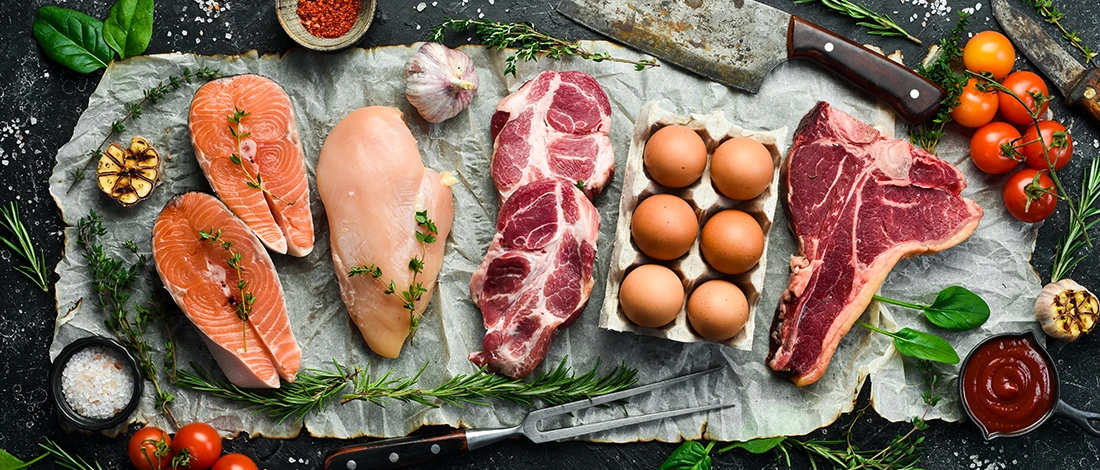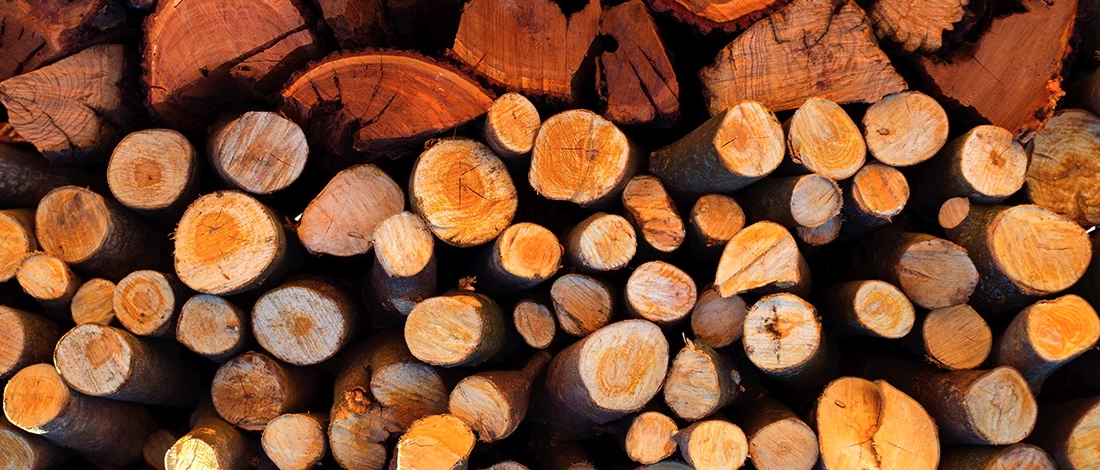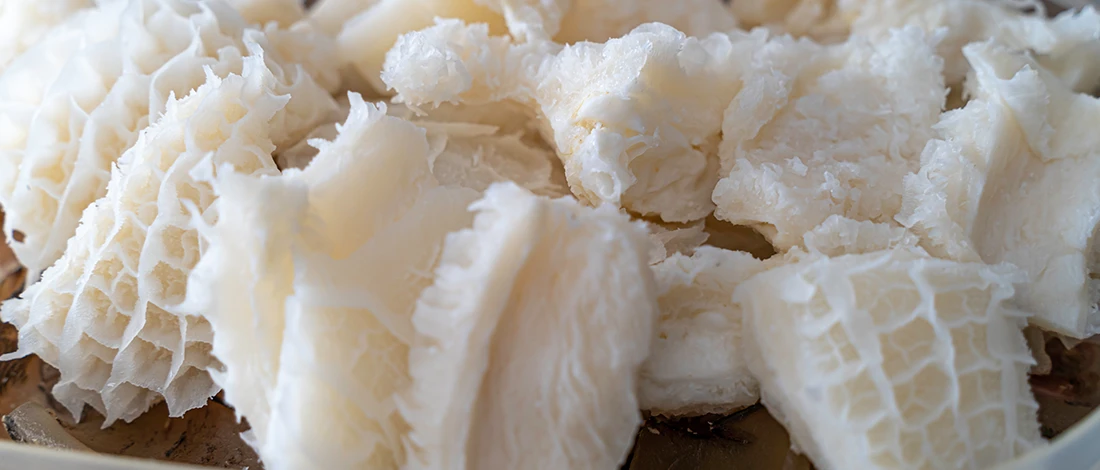As a professional chef with years of experience in preparing different types of meat, I can attest that no single meat can compare to the indulgent flavors found in perfectly cooked ribs.
Whether you're a seasoned meat lover or new to the game, I'll provide a comprehensive guide to the different types of ribs to help you decide which is best for your next meal.
Quick Summary
- Pork ribs are the most popular type of ribs and come in three basic types: spare, baby back, and St. Louis-style.
- Beef ribs are meatier and fattier than other types of ribs and come as short ribs, back ribs, and Franken-style ribs.
- Lamb ribs are not as common as beef or pork ribs but are still delicious when prepared correctly.
Types of Beef Ribs
Beef ribs are generally the largest and meatiest kind of ribs. The three main types of beef ribs are short ribs, back ribs, and flanken-style ribs. These beef cuts come from the plate, rib primal, and chuck, respectively [1].
1. Short Ribs

Beef short ribs are cut from the chuck, located in the shoulder area. They are meatier and fattier than other beef ribs. When preparing chuck short ribs, it's essential to sear them first to lock in the flavor and moisture.
You can prepare beef short ribs with various cooking methods, such as in a Dutch oven with vegetables and beef broth, in a slow cooker with barbecue sauce, or smoked for several hours with a dry rub.
The result is fork-tender rib meat that practically falls off the bone. Chuck short ribs have an intensely beefy flavor and a rich, fatty texture that pairs well with bold flavors like red wine, garlic, and rosemary.
Note that these are different from boneless beef short ribs, which come directly from the beef chuck. Boneless short ribs can be cooked faster and over higher heat.
2. Back Ribs
Beef back ribs are rib cuts from the upper portion of the rib area near the spine. They have more meat than their pork counterparts, known as baby back ribs.
The meat is located between the rib bones, and the key to making the most of the flavor is to cook beef back ribs over indirect heat, smoke, or grill them low and slow.
To prepare beef back ribs, create a dry rub with your favorite spices, a wet marinade, or a store-bought barbecue sauce.
Place them in a smoker with hickory or applewood chips and cook until they fall off the bone.
If grilling, be sure to baste beef back ribs with your sauce often and watch them closely to avoid burning.
3. Flanken-Style Ribs
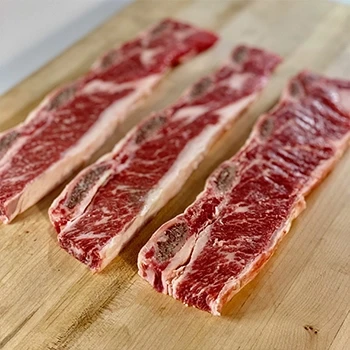
Flanken-style ribs are found in Asian cuisines. They are cut across the bone, exposing small pieces of meat between each bone.
The ribs tend to be thin and wide, making them easy to cook faster than short ribs.
Flanken ribs are commonly used in dishes like Korean bibimbap and kalbi-style beef (“beef galbi”). Marinating these ribs in a flavorful sauce for hours or even overnight before grilling ensures that the meat is tender and the flavors are absorbed.
When grilling, keep a close eye on your flanken ribs since they cook quickly and can burn easily.
"Nothing brings people together like a big plate of delicious ribs."
- Guy Fieri, American Chef
Types of Pork Ribs
Pork ribs are the most popular and widely available type of rib. There are three basic pork ribs: spare ribs, baby back ribs, and St. Louis-style ribs.
There is also a cut known as country-style ribs, which are not technically a rib but are still popular [2].
Additionally, you can get pork short ribs, though they are just the extension of baby back ribs into the shoulder.
1. Spare Ribs
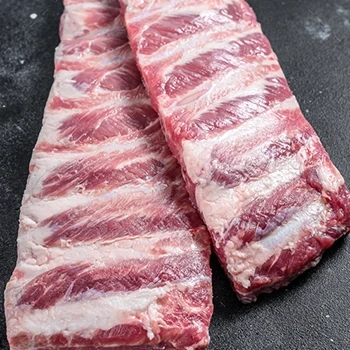
Pork spare ribs are cut from the breast bone area and contain a good amount of meat and flavorful fat, making them excellent when slow-cooked or smoked at low temperatures.
They have more connective tissue than baby back ribs, so they are a bit tougher. This is why they are best cooked low and slow to allow the collagen to melt down and make the meat tender.
When preparing pork spare ribs, removing the membrane from the bone side of the rack before cooking is recommended. This will help the meat to absorb more flavor and smoke.
They can then be seasoned with a simple dry rub or marinated in a wet sauce.
2. Baby Back Ribs
Baby back ribs, also called loin ribs or loin back ribs, are cut from the upper part of the rib cage where the rib meets the spine. They do not come from baby pigs but are just smaller and leaner than spare ribs.
They are perfect for grilling or smoking and cook faster than spare ribs. Baby back ribs run from the shoulder to the loin meat, so they are lean and can easily be overcooked and dry out.
To cook baby backs, remove the membranous connective tissue on the rib side, season them with your favorite dry or wet rub, and let them rest for several hours.
This lean meat can be placed on the grill, smoker, or oven. Many people like to smoke them for several hours before putting them on the grill for a quick sear with a brush of barbecue sauce or glaze.
The attached meat of baby backs is prized for being tender and juicy. The bones are shorter and curvier, making them excellent barbecue ribs and finger food.
Related Articles:
3. St. Louis-Style Ribs

St. Louis-style ribs come from the same part of the rib cage as the spare rib. They trim spare ribs into a rectangular shape perfect for barbecuing. They have more meat than baby back ribs but are quicker to cook than spare ribs.
St. Louis-cut ribs get their name from the city where they were first popularized.
To prepare them:
- Remove the unwanted flap of meat and cartilage and trim them to achieve a rectangular shape.
- Season the rib section with your favorite dry rub and smoke them on low heat over several hours.
- Once the meat is tender, finish them on the grill with barbecue sauce or your favorite glaze.
4. Country Style Ribs
Not officially ribs, country-style pork ribs are pork rib chops cut from the blade end of the pork loin, nearest to the shoulder.
They may have a narrow portion of rib bone and are fattier than other ribs, giving them a rich and hearty flavor. They have the most meat of any pork cut.
Bone-in or boneless country-style ribs are best prepared by covering them with a dry rub or sauce before cooking.
They can be slow-cooked until they are juicy and tender or cooked over high heat to give them that smoky flavor. To keep the meat moist and tender, it's important not to overcook them.
Country-style ribs are an excellent option for those who like their meat a little sweet, savory, or spicy. They can be paired with barbecue sauce, apple cider vinegar, or bourbon.
Read More: Traeger Country-Style Ribs
Lamb Ribs
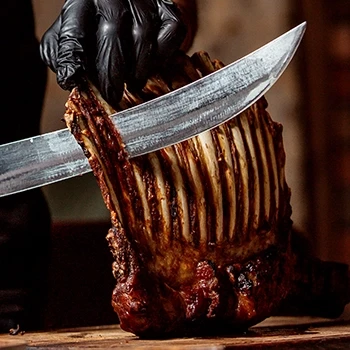
Lamb riblets are a lesser-known cut of meat that is becoming more popular among carnivores. They are typically smaller than beef or pork ribs but make up for it with their rich flavor and tender meat.
One of the most common ways to prepare lamb ribs is by slow-cooking them in the oven or on the grill.
This method allows the meat to become tender and juicy. Lamb riblets can also be braised or boiled, but this may result in a less flavorful final product.
When seasoning lamb riblets, many prefer to keep it simple with salt, pepper, and garlic. However, lamb pairs well with many herbs and spices, such as rosemary, thyme, cumin, and coriander.
It's important to note that lamb riblets can be a bit fatty, so they may not be the best option for those watching their fat intake. However, the fat content also contributes to the meat's rich flavor and tender texture.
Other Meat

While beef, pork, and lamb are the most commonly consumed ribs, other meats can be used to make delicious and flavorful ribs in the barbecue world.
Some of these alternatives include:
- Goat ribs: These ribs have a unique flavor and are often described as gamey. They are commonly prepared with olive oil and used in African and Caribbean cuisines.
- Bison ribs: These ribs are leaner than beef ribs and have a slightly sweeter taste. They are low in fat and an excellent alternative for those seeking a healthier option.
- Deer ribs: These ribs have a strong flavor and are often used in stews and soups.
Rib cookery for other meat ribs is similar to pork or lamb. Low and slow cooking techniques are often best to ensure the meat is tender and flavorful. Rubs and marinades can also add extra flavor to this cooking method.
FAQs
What Type of Ribs Do Most Restaurants Use?
Most restaurants use pork ribs, specifically spare ribs or baby back ribs, as they are more widely available and cost-effective than beef and lamb ribs. Additionally, pork ribs are a popular choice due to their tender, juicy, flavorful meat.
What Type of Ribs Are the Most Expensive?
The most expensive type of ribs is typically short ribs, which come from high-end cuts around the prime rib and bone-in ribeye steaks. They require more time and effort to prepare due to their size and density. Lamb ribs can also be pricey due to their limited availability and the care needed to rear and produce them.
What Are the Meatiest Ribs to Buy?
The meatiest ribs to buy are country-style pork ribs. Unlike traditional ribs, which are comprised of both bone and meat, country-style ribs come from the chuck end of the pork and are meatier. Additionally, country-style ribs are versatile and can be grilled, smoked, baked, or braised.
References:
- https://edgewoodlocker.com/new/wp-content/uploads/2019/08/BEEF-CUT-SHEET-1.pdf
- https://nourish.schnucks.com/articles/types-of-pork-ribs/




